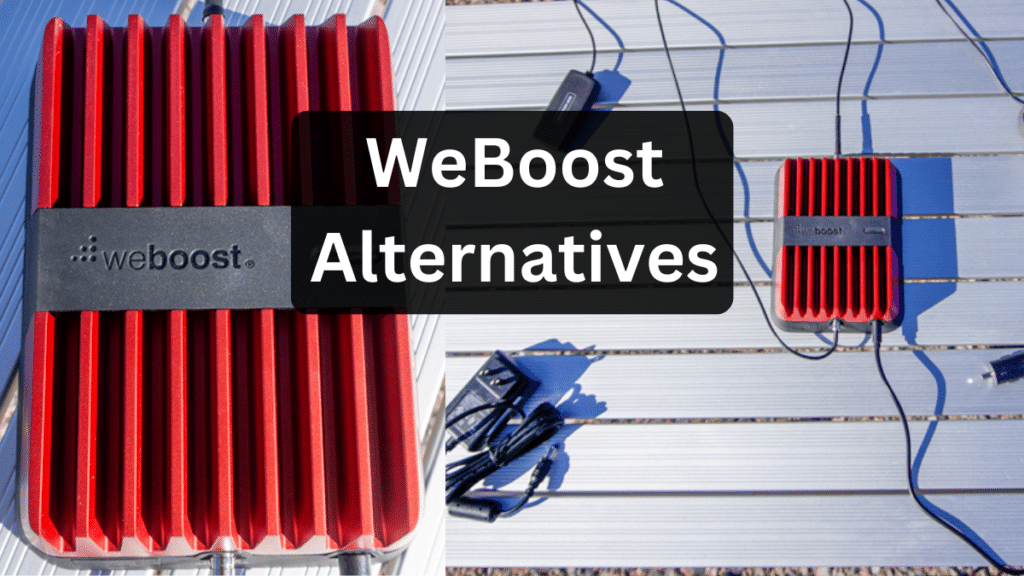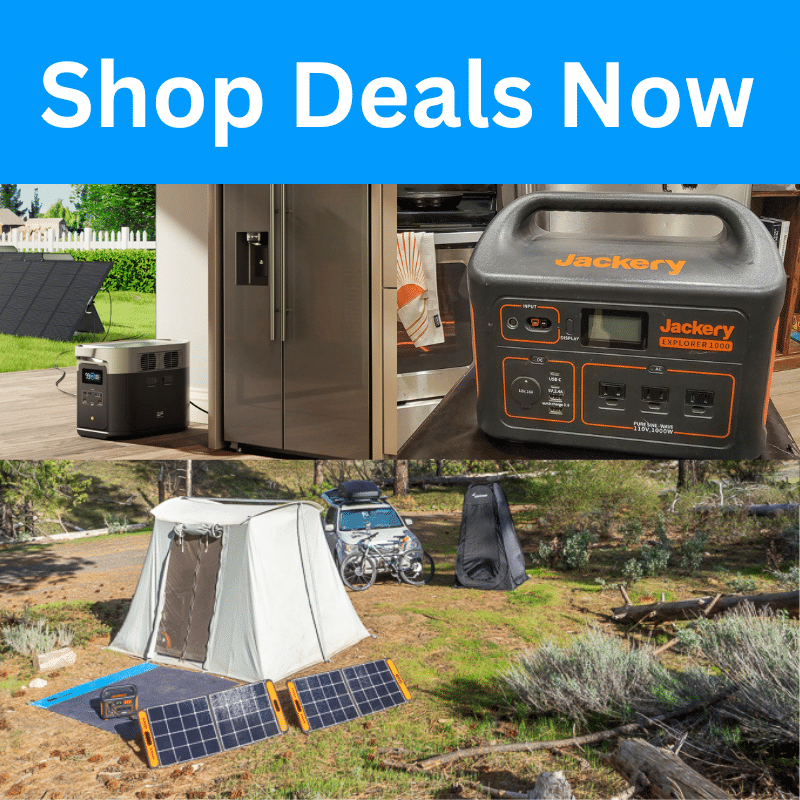Struggling to maintain reliable connectivity while adventuring in remote locations is a common hurdle for digital nomads.
WeBoost, a popular solution to this problem, isn’t always the perfect fit for everyone.

This guide aims to explore the strengths and weaknesses of WeBoost and shed light on viable alternatives that might suit your needs better.
Note: Some product links in this article will go to Amazon, Etsy, or other marketplaces where I earn a commission no matter which product you choose. This helps keep display ads off this website. Thanks!
Understanding WeBoost and Its Limitations
WeBoost is essentially a low-power repeater for cell signals.
In ideal conditions, it boosts cell reception effectively, resulting in better call quality and faster internet speeds.
However, WeBoost can only amplify what’s available. If the signal is weak or non-existent, there isn’t much for WeBoost to amplify.
For those venturing into the middle of nowhere, consider satellite internet options, like Starlink (Starlink vs Weboost). These services offer wider coverage and could be an effective solution when terrestrial networks fall short.
Why WeBoost Isn’t Always the Best Answer
One common misconception is that WeBoost is a magic solution that works equally well for all. However, user experiences suggest otherwise. Here are a few observations:
User Experience Stories
One digital nomad reported that WeBoost only improved their data connection around 5% of the time, suggesting that the Omni antenna isn’t as effective as one might hope (as compared to a directional antenna).
In some cases, placing your device in direct line of sight with the cell tower, or elevating your hotspot device, may deliver better results.
Best WeBoost Alternatives
Though I enjoy WeBoost (read my Weboost Review) other options could provide better performance in certain scenarios.
Here’s the WeBoost so you can compare current prices. Then the alternatives are after.
My WeBoost is the Drive Reach and it works great. This WeBoost Drive Reach OTR is what I see often in the wild for overlanding and RVers.
HiBoost
HiBoost offers a range of cell signal boosters designed to enhance 4G, LTE, and 3G cell signals. Their products are tailored for use in various settings, including cars, RVs, and buildings.
- Provides enhanced stability and stronger signals in areas with poor signal.
- Made from durable metal with a heat-dissipating design for longevity.
- Omni-directional antenna compatible with all major carriers and supports 5G.
- Comes with the "Signal Supervisor" app for live status monitoring.
- Custom-designed for RVs and campers with a 26ft cable and FCC approved for safety.
As with all signal boosters, the effectiveness of HiBoost’s products can largely depend on the existing signal strength.
SureCall
Another viable WeBoost alternative is SureCall, which provides a variety of cell phone signal boosters designed for use in vehicles, homes, and commercial buildings.
- High-performance booster compatible with all North American carriers, improves 5G/4G LTE signal strength for all devices including hotspots.
- Heavy-duty, weather-resistant exterior antenna designed for durable and long-lasting use in harsh conditions.
- Customizable antenna height with optional mast extension, and flexible mounting options on any surface.
- Ensures reliable connectivity for multiple simultaneous users inside the vehicle.
- USA-based company offering an industry-best 3-year warranty and lifetime tech support
They cater to multiple carriers and support multiple simultaneous users – a feature that may prove particularly useful for teams on the move.
Cel-Fi Go X
The Cel-Fi Go X Vehicle is a high-powered cell signal booster that boasts a 100db gain making it the strongest consumer signal booster on the market.
- Cel-Fi GO X cell signal booster kit includes a single dome and panel antenna for flexibility.
- Offers a 100dB single-carrier booster advantage, boosting signal 40 dB more than other boosters for better data rates and larger coverage area.
- Designed to provide faster data rates and perfect coverage, eliminating dropped calls and poor audio quality.
- The booster supports one cell carrier at a time, ideal for AT&T, Verizon, or T-Mobile users.
- Fully FCC certified, designed in California.
If maximum power is what you’re after, and you have enough antenna separation to prevent oscillation, this might be an excellent option for you.
The Cel-Fi GO X is a powerful, single-carrier booster that provides an impressive 100dB gain, much higher than most boosters on the market. This means it can significantly improve data rates, coverage area, and cell signal quality.
However, due to its high power, it’s crucial to have enough separation between the included dome and panel antennas to prevent oscillation (a feedback loop akin to the high-pitched noise you hear when a microphone is too close to a speaker). This is a standard practice to ensure optimal performance for any cell signal booster.
If set up correctly, this booster can provide powerful coverage and improved call quality and data speeds, making it an excellent option for users prioritizing maximum power. The ability to choose between a dome or panel antenna based on your specific installation needs adds to its versatility.
Cheaper WeBoost Options
If cost is a significant concern, you might want to explore budget-friendly alternatives to WeBoost.
- Dual band cell phone booster designed to improve 5G/4G LTE data and voice quality for major carriers including Verizon and AT&T.
- Supports all brands of phones and multiple users, ideal for fast uploads and downloads for data-heavy apps.
- Features automatic gain control and easy setup with no technical experience needed, adjusts for optimal performance.
- Comes with outdoor magnet antenna, indoor patch antenna, power adapter, and user manual. FCC approved with a 3-year manufacturer guarantee.
- Versatile usage across different types of vehicles such as cars, trucks, RVs, boats, and more.
However, not all of them are FCC registered, which is an issue I don’t know enough about, but I don’t want to deal with it.
Some users have reported satisfactory results with less expensive signal boosters found on Amazon. However, be cautious and ensure you’re buying genuine products, as many fakes are on the market.
The Power of Redundancy: Multiple Service Providers
Using multiple service providers can be a practical strategy to ensure connectivity. Users often find that if one network is available, there’s a good chance another might be as well. Moreover, if signal strength varies across carriers, having options can be beneficial.
Antennas, Boosters, and Hotspots: A Comparative Analysis
Several users reported having success with MIMO (Multiple Input, Multiple Output) antennas, which they found provided faster download speeds compared to WeBoost. Devices like Verizon’s Jetpack can use these antennas to enhance their signal reception.
Note: there is a one-time fee for the device, then you have to work with Verizon to get it activated and added to your plan. It's cheap to add to existing plans.
Boosters like the WeBoost Drive Sleek or Drive Reach are also worth considering, especially for those frequently in motion. Meanwhile, LTE routers can offer a more robust connectivity solution with built-in GPS and other features.
Making the Right Decision: Personalizing Your Connectivity Strategy
Ultimately, the best solution for you will depend on your specific needs, location, and budget. While some people find a certain setup beneficial, it might not work as well for others.
Remember, it’s not only about bars and speed. Things like latency, or ping, can greatly affect your ability to work. Redundancy by having at least two providers can be more crucial than any booster or antenna.
Consider your requirements, research thoroughly, and don’t be afraid to experiment. Keep in mind, flexibility and adaptability are key in maintaining steady connectivity while on the road.
The Bottom Line
Choosing between WeBoost, an external hotspot, or both, can be a challenging decision. You need to carefully consider your unique circumstances, needs, and budget.
Moreover, understand that the best solution for you might involve a combination of these options or perhaps a different alternative entirely.
The good news is that the evolving tech landscape offers numerous potential solutions to maintaining reliable connectivity, even in the most remote locations.
Experiment, find what works best for you, and enjoy your digital nomad lifestyle without the stress of disconnection. Many of these products offer 30 or even 90 days (WeBoost) to try them out.






